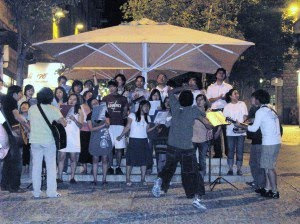The condo we stayed in was perfect and the view, incredible. Stepping out onto our balcony, as your eyes looked to the left and began scanning the horizon, there was the yeshiva, the place where the Hassidic Jews trained in their study of the Torah and then the Old City with its larger than life, gleaming Dome of the Rock, an ever present reminder of the Muslim presence in Jerusalem. Again, the view was a visual paradox of the competing faiths always present in Israel. Today was different. After spending four days in Jerusalem, we were heading to Zippori, a small farming community in the Galilee region. This would enable us to easily navigate within Galilee where Jesus spent the majority of his ministry, with our home base not far from any one site.
 Where Jerusalem was a mountainous city scattered with cinder block buildings, homes and lots of stone, the view before me now made me so thankful for the air conditioned rental car we had to travel in. All that you could see for miles was vast, clay colored desert. What looked like great mounds of sand was actually mountains of limestone. Nothing green was in sight, no sign of life, except the occasional Bedouin, a person whose home is the desert. The Bedouin travels this dry, hot, desolate land, with their camels and goats, living off the money they make from selling goat milk or pictures of tourists on their camels!
Where Jerusalem was a mountainous city scattered with cinder block buildings, homes and lots of stone, the view before me now made me so thankful for the air conditioned rental car we had to travel in. All that you could see for miles was vast, clay colored desert. What looked like great mounds of sand was actually mountains of limestone. Nothing green was in sight, no sign of life, except the occasional Bedouin, a person whose home is the desert. The Bedouin travels this dry, hot, desolate land, with their camels and goats, living off the money they make from selling goat milk or pictures of tourists on their camels!Soon the landscape began to change. We began to see green! The land had obviously been irrigated to support the immense date palm orchards we passed. Rows and rows of date palms grew the incredible, giant size dates we had already enjoyed. The dates hung in large clusters from the branches of the trees, sagging from the weight of their fruit not yet ripe for picking. To our right was the neat and orderly rows of palm trees that seemed to go on forever, to our left, the Dead Sea, a welcome site that seemed to quench the thirsty desert we had traveled through for miles and miles. The Dead Sea is the lowest point on earth. It is over 1,300 feet below sea level. The oxygen is so rich here that many with respiratory problems such as asthma or other chronic lung diseases feel much better than at above sea level elevations. The Dead Sea is also the site of resorts and spas. Many swear by the therapeutic effects of many of the Dead Sea components. It is not unusual to see visitors covered in the dark, Dead Sea mud as a sort of “mask” for the body. Because of the its location below sea level, the UVB and UVA are blocked so you can get a tan without fear of sunburn! Okay ladies, did I hear someone say “Road trip?!”….or should I say, “Plane trip?!”
Not long after the scenery had changed, we arrived at Qumran, where mountains of rocks had large holes quarried from their surface; the site where the Dead Sea scrolls were found. As I scanned the caves from a distance, a child like feeling of intrigue and adventure came over me like that of a Nancy Drew mystery I was determined to solve! “Which one of these caves is the one where the Dead Sea Scrolls were found?” I asked. “We’ll never know,” Rob responded, “They’re not telling.” I looked up again at the large cave like holes that dotted the mountainside and thought to myself, “Which one could it be? I would love to find out….” My childlike fantasy was interrupted by the reminder that we needed a cold drink and to move on. There was more to see….much more.















